Exploring German cuisine offers a delectable peek into the country’s rich cultural tapestry, characterized by hearty ingredients, robust flavors, and a tradition of communal dining. From the bustling beer gardens of Bavaria to the vine-covered hills of the Rhine, German food celebrates regional diversity and historical depth. This guide dives into classic German recipes that promise to bring the warmth of Deutschland right into your kitchen.
The Foundations of German Cuisine
German cuisine is known for its emphasis on meat, potatoes, and breads. Pork, beef, and poultry are the most commonly consumed meats, with each region showcasing its own specialty. The culinary landscape in Germany also features a variety of sausages, known as ‘Wurst’, which are cherished nationally and internationally.
Dairy products like cheese and fresh cream are staples, and they complement the dense, wholesome breads that vary from rye to pumpernickel. Meanwhile, vegetables such as cabbage, carrots, and turnips are commonly incorporated into meals in the form of pickles, stews, or side dishes.
A Tour of German Dishes
1. Sauerbraten (German Pot Roast)
Sauerbraten is a testament to the German art of marinating. Typically prepared with beef, the meat is marinated for several days in a mixture of vinegar, water, and spices before being slow-cooked until tender. The result is a flavorful and succulent roast that is usually served with red cabbage, potato dumplings, or Spätzle.
2. Wiener Schnitzel
Although originally from Austria, Wiener Schnitzel is a beloved dish throughout Germany. It features thin, breaded, pan-fried veal cutlets that are crispy on the outside and tender on the inside. Serve with a slice of lemon, creamy potato salad, or cucumber salad for a traditional meal.
3. Bratwurst with Sauerkraut
No German food discussion is complete without the mention of Bratwurst. These flavorful sausages are made from pork, veal, or beef and are often grilled or pan-fried. Paired with sauerkraut—a fermented cabbage dish—and mustard, Bratwurst is a staple at German festivals and barbecues.
4. Kartoffelsalat (German Potato Salad)
Kartoffelsalat differs from American potato salads in that it typically uses a vinegar-based dressing rather than mayonnaise and includes ingredients like bacon, onions, mustard, and fresh herbs. This salad can be served warm or cold and is a common side dish at many German gatherings.
5. Schwarzwälder Kirschtorte (Black Forest Cherry Cake)
For dessert, nothing is more iconic than the Schwarzwälder Kirschtorte, or Black Forest Cherry Cake. This indulgent treat is made with layers of chocolate sponge cake, whipped cream, and cherries, laced with Kirsch, a cherry brandy. It’s a celebratory dish, often served at special occasions and family gatherings.
Cooking Tips for Authentic German Flavors
When preparing German recipes, consider these tips to ensure authenticity:
- Marinate Meats Thoroughly: For dishes like Sauerbraten, allow the meat to marinate for several days to absorb all the flavors fully.
- Use Quality Ingredients: German cooking relies heavily on the quality of its ingredients. Use fresh vegetables, high-quality meats, and the best spices you can find.
- Balance Flavors: German cuisine often balances rich meats with acidic components like pickles or sauerkraut to cut through the richness.
- Cooking Techniques: Mastering slow-cooking and roasting techniques will help achieve the true depth of flavor typical in German dishes.
German cuisine is a robust and flavorful reflection of the country’s rich history and agricultural heritage. By exploring these recipes, home cooks can experience the depth and breadth of German culinary traditions. Whether you’re hosting a festive Oktoberfest-themed dinner or simply looking for comforting meals, these dishes offer something uniquely satisfying for every palate.
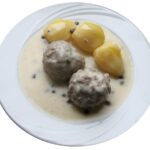 Authentic Königsberger Klopse Recipe: A Taste of German Tradition - Königsberger Klopse, a traditional German dish, is a delightful blend of flavors and textures that has been savored for generations. Originating from the city of Königsberg (now Kaliningrad, Russia), this recipe has become a staple in German cuisine. In this comprehensive guide, we’ll walk you through the steps to create this classic dish, complete with […]
Authentic Königsberger Klopse Recipe: A Taste of German Tradition - Königsberger Klopse, a traditional German dish, is a delightful blend of flavors and textures that has been savored for generations. Originating from the city of Königsberg (now Kaliningrad, Russia), this recipe has become a staple in German cuisine. In this comprehensive guide, we’ll walk you through the steps to create this classic dish, complete with […] Desserts - Desserts in German cuisine are as diverse as the rest of the cuisine. Popular desserts include cakes, pastries, cookies, egg-based dishes, crepes, fruit (including fresh, baked, and cooked), creams, quark-based dishes, chocolate, and candies. Ice cream is also a popular dessert of Germans. This love of ice cream began in the 1920’s when Italian immigrants […]
Desserts - Desserts in German cuisine are as diverse as the rest of the cuisine. Popular desserts include cakes, pastries, cookies, egg-based dishes, crepes, fruit (including fresh, baked, and cooked), creams, quark-based dishes, chocolate, and candies. Ice cream is also a popular dessert of Germans. This love of ice cream began in the 1920’s when Italian immigrants […] German Baking Recipes - A wide variety of cakes and tarts are served throughout Germany, most commonly made with fresh fruit. Apples, plums, strawberries, and cherries are used regularly in cakes. Cheesecake is also very popular, often made with quark. Schwarzwälder Kirschtorte (Black Forest Cake, made with cherries) is probably the most well-known example of a wide variety of […]
German Baking Recipes - A wide variety of cakes and tarts are served throughout Germany, most commonly made with fresh fruit. Apples, plums, strawberries, and cherries are used regularly in cakes. Cheesecake is also very popular, often made with quark. Schwarzwälder Kirschtorte (Black Forest Cake, made with cherries) is probably the most well-known example of a wide variety of […]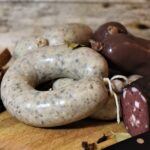 German Blutwurst Recipe: A Traditional Delight - German Blutwurst, or blood sausage, is a unique and traditional delicacy that has been a staple in German cuisine for centuries. With its rich flavors and distinct texture, Blutwurst is a testament to the diversity and depth of German culinary arts. This article will guide you through the process of making authentic German Blutwurst at […]
German Blutwurst Recipe: A Traditional Delight - German Blutwurst, or blood sausage, is a unique and traditional delicacy that has been a staple in German cuisine for centuries. With its rich flavors and distinct texture, Blutwurst is a testament to the diversity and depth of German culinary arts. This article will guide you through the process of making authentic German Blutwurst at […] German Christmas Recipes - It is that time of the year again! The nature is deep in winter, and December days are passing by inevitably, getting us nearer to Christmas. This holiday is the best time for cooking something special, something delicious and absolutely festive. The traditional German holiday meal consists of duck, goose, rabbit or a roast, accompanied […]
German Christmas Recipes - It is that time of the year again! The nature is deep in winter, and December days are passing by inevitably, getting us nearer to Christmas. This holiday is the best time for cooking something special, something delicious and absolutely festive. The traditional German holiday meal consists of duck, goose, rabbit or a roast, accompanied […] German Easter Recipes: Traditional Dishes for a Festive Ostern - Easter (Ostern) in Germany is not just about egg hunts and bonfires—it’s also a time for delicious, traditional meals that bring families together. From sweet Easter lamb cakes (Osterlamm) to hearty Festtagsbraten (holiday roasts), German Easter cuisine is a delightful mix of regional specialties and time-honored dishes. In this section, discover the best German Easter […]
German Easter Recipes: Traditional Dishes for a Festive Ostern - Easter (Ostern) in Germany is not just about egg hunts and bonfires—it’s also a time for delicious, traditional meals that bring families together. From sweet Easter lamb cakes (Osterlamm) to hearty Festtagsbraten (holiday roasts), German Easter cuisine is a delightful mix of regional specialties and time-honored dishes. In this section, discover the best German Easter […]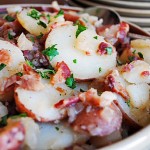 German Salad Recipes - Germany is often celebrated for its hearty meats, rich gravies, and iconic baked goods—but there’s an equally important side to German cuisine that deserves the spotlight: salads. Known as Salate in German, these dishes are much more than a light starter or side—they’re an essential part of the country’s culinary identity. Whether served warm or […]
German Salad Recipes - Germany is often celebrated for its hearty meats, rich gravies, and iconic baked goods—but there’s an equally important side to German cuisine that deserves the spotlight: salads. Known as Salate in German, these dishes are much more than a light starter or side—they’re an essential part of the country’s culinary identity. Whether served warm or […] German Sauerkraut with Apples Recipe - German cuisine is renowned for its rich flavors, hearty ingredients, and comforting dishes. Among these, Sauerkraut stands out as a staple, deeply rooted in German culture. Adding apples to Sauerkraut brings a delightful twist to this traditional dish, balancing the tangy flavor of fermented cabbage with the sweet, crisp notes of apples. This article delves […]
German Sauerkraut with Apples Recipe - German cuisine is renowned for its rich flavors, hearty ingredients, and comforting dishes. Among these, Sauerkraut stands out as a staple, deeply rooted in German culture. Adding apples to Sauerkraut brings a delightful twist to this traditional dish, balancing the tangy flavor of fermented cabbage with the sweet, crisp notes of apples. This article delves […] Halloween Recipes - While this celebration of all things ghoulish and creepy isn’t celebrated on such a grand scale as it is in the United States, Halloween has become increasingly popular in Germany over the past decades. German children have discovered the delights of dressing up in funny or spooky costumes to practice the fun tradition of trick-or-treating. […]
Halloween Recipes - While this celebration of all things ghoulish and creepy isn’t celebrated on such a grand scale as it is in the United States, Halloween has become increasingly popular in Germany over the past decades. German children have discovered the delights of dressing up in funny or spooky costumes to practice the fun tradition of trick-or-treating. […]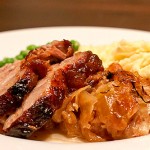 Main Dishes - Traditional German cuisine is rich and hearty, but it is also extremely delicious. German cuisine also differs widely during the year. Mushrooms, game, vegetables, they all have their season. It is the secret of many German dishes that they are cooked with local and fresh ingredients. Germany is famous for its variety of bread and […]
Main Dishes - Traditional German cuisine is rich and hearty, but it is also extremely delicious. German cuisine also differs widely during the year. Mushrooms, game, vegetables, they all have their season. It is the secret of many German dishes that they are cooked with local and fresh ingredients. Germany is famous for its variety of bread and […]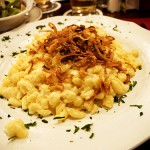 Sauerkraut Recipes - Sauerkraut is probably the most well known German food. Sauerkraut is finely sliced green cabbage that has been fermented by lactic acid bacteria. The fermentation process (also known as pickling) gives the cabbage a distinct sour flavor, which is where it gets the name Sauerkraut (sour cabbage). In Germany, sauerkraut is often flavored with juniper […]
Sauerkraut Recipes - Sauerkraut is probably the most well known German food. Sauerkraut is finely sliced green cabbage that has been fermented by lactic acid bacteria. The fermentation process (also known as pickling) gives the cabbage a distinct sour flavor, which is where it gets the name Sauerkraut (sour cabbage). In Germany, sauerkraut is often flavored with juniper […] Traditional Sauerbraten Recipe: A German Classic That Stands the Test of Time - Sauerbraten, a gem in the crown of German cuisine, is a pot roast, usually of beef (but other meats such as lamb, mutton, pork, and traditionally, horse), marinated before slow-cooking as pot roast. The meat is typically marinated for several days in a mixture of vinegar or wine, water, herbs, spices, and seasonings before being […]
Traditional Sauerbraten Recipe: A German Classic That Stands the Test of Time - Sauerbraten, a gem in the crown of German cuisine, is a pot roast, usually of beef (but other meats such as lamb, mutton, pork, and traditionally, horse), marinated before slow-cooking as pot roast. The meat is typically marinated for several days in a mixture of vinegar or wine, water, herbs, spices, and seasonings before being […]





